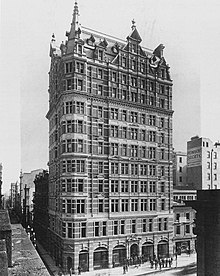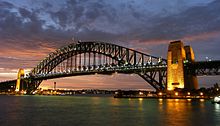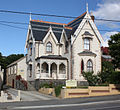Architecture of Australia
| This article is part ofa serieson the |
| Culture of Australia |
|---|
 |
| Society |
| Arts and literature |
| Other |
| Symbols |
|
Australia portal |
Architecture of Australiahas generally been consistent with architectural trends in the widerWestern world,with some special adaptations to compensate for distinctive Australianclimaticandcultural factors.Indigenous Australiansproduced a wide range of structures and places prior to colonisation. Contemporary Indigenous practitioners are active in a broad range of built environment fields. During Australia's earlyWesternhistory, it was a collection of British colonies in whicharchitectural styleswere strongly influenced byBritishdesigns. However, the unique climate of Australia necessitated adaptations, and 20th-century trends reflected the increasing influence ofAmericanurban designs and a diversification of the cultural tastes and requirements of an increasinglymulticulturalAustralian society.
Iconic Australian designs include theUNESCOlistedSydney Opera House,MelbourneRoyal Exhibition Building,Brisbane City Halland the11 remnant penal colony sitesselected for World Heritage protection in 2010.
Towards theFederation of Australiathere was a concerted movements to create a distinctively Australian styles along with theAustralian nationalismmovement, some of which incorporated decorativeAustraliana.While these attempts were largely unsuccessful due in part tocultural cringe,distinctively Australian styles of architecture had already evolved organically. Notable Australian architectural adaptations include theQueenslanderandFederationstyles of residential architecture.
History
[edit]
In the period beforeEuropean settlement of Australia,there were diverse forms ofIndigenous architectureacross Australia. The rich architecture traditions of Aboriginal and Torres Strait Islander peoples generally went unrecognised, and when it was recognised generally downplayed by the European Settlers.[1]However, many early colonists and explorers includingSir Thomas MitchellandCharles Sturtrecorded many Indigenous building styles including stone houses and houses grouped in villages.[1]As aBritish colony,the first European buildings were derivative of the European fashions of the time. As most of the colonialists where from England the first buildings reflected English ideas.[2]
Georgian architectureis seen in early government buildings and the homes of the wealthy. The architectFrancis Greenway,who appears on theAustralian ten-dollar notedesigned early buildings in the Georgian style. Examples include theHyde Park Barracks,St James' Churchand St Matthews Church atWindsor.[2]
Another European style to gain favour in 19th century Australia, particularly in churches, wasGothic Revival architecture.Pointed arches, turrets, battlements and gothic ornaments could also be found on bank, insurance offices, university buildings and homes.[2]One of the best examples of this style can be seen at the lower end ofCollins StreetinMelbourne.

With theAustralian gold rushesof the mid-19th-century major buildings, largely inMelbourneandSydneyand to a lesser extent in regional capitals such asBallaratandBendigowere built in the style ofVictorian architecture.[citation needed]From about 1850 to 1893Italianate architecturewas also popular as it allowed greater displays of prosperity through rich and ornate decorate features such ascast ironlace work and slate roofs.[2]Towards the end of the century the style was pushed to an extreme by some architects. Buildings became over-burdened with excess columns, balustrades, exaggerated entrances and other lavish decorations.Medley HallinCarltonis an example of this style which became known as theBoom Stylefrom 1880 to 1893.[2]
One of the most significant architectural movements in Australian architecture was theFederation architecturestyle of the turn of the 20th century, where Australia began to play with the idea of a "style of our own", and the modern styles of the late 20th century which sought to reject historicism.
Walter Burley Griffinwas an Americanarchitectand landscape architect who, with fellow architectMarion Mahony Griffin,played a key role in designingCanberra,Australia's capital city. A legacy of their unique architecture remains in a small number of Melbourne buildings and the Sydney suburb ofCastlecrag.Castlecrag was planned by the Griffins and also features a number of houses designed in the organicModerniststyle they developed after thePrairie Schoolarchitecture that marked his earlier career in theUnited States.The simple, flat-roofed cottages that the Griffins designed in Canberra used their innovative, patented techniques forconcreteconstruction.
One of the most important local introduction to Australian architecture was theverandah.[2]As pastoralists took up land and built solid, single story dwellings the addition of verandahs proved popular as they provided shade and looked attractive. They were often integrated into the symmetry of Georgian style homes.[2]
Like elsewhere in the world, socio-political factors have played their roles in shaping Australian architecture. During the early 20th century, cities across Australia had placed building height limits, typically 150 feet (45 m), thus hampering the development of American-styleskyscrapersuntil the limits were lifted in the late 1950s. Likewise the popular notion of the "Australian Dream",in which families seek to own their free-standing houses with backyards, meant that high-density housings were rare in Australia until the end of the 20th century. The design of housing in Australia after World War II, which was mostly undertaken by builders, has been described as poor aesthetically and environmentally.[4]
Significant concern was raised during the 1960s, withgreen bansand heritage concerns responding to the destruction of earlier buildings and the skyscraper boom, particularly in Sydney and Melbourne, but affecting other major cities including Adelaide, Perth and Brisbane. Green bans helped to protect historic 18th-century buildings inThe Rocksfrom being demolished to make way for office towers, and prevented theRoyal Botanic Gardensfrom being turned into a carpark for theSydney Opera House.In Melbourne a battle was fought to preserve historicCarlton, Victoriafrom slum reclamation forpublic housing,whilegentrificationplayed a big part in the suburb's salvation. In Melbourne's city centre, the destruction was particularly profound:Whelan the Wreckerwas a family owned and operateddemolitioncompany that operated from 1892 until 1992, which became well known through the 1950s, 70s and 80s when signs stating that "Whelan the Wrecker is Here" appeared on many of the grand Victorian era buildings ofMarvellous Melbourne.One of the most lamented losses in Melbourne was theFederal Coffee Palaceon Collins Street and theAPA Building(inspired by Chicago's early skyscrapers) at 49Elizabeth Street.Many of the destruction occurred after theInternational Modernismstyle arrived in Australia, making Australians particularly conscious about Victorian architecture they felt was "dated".[5]
In the 21st century, many Australian architects have taken a moreavant-gardeapproach to design, and many buildings have emerged that are truly unique and reflective of Australia's culture and values. As a result, many Australian practices are beginning to expand their influence overseas rather than the reverse which was often the case. Melbourne is seen as the city at the forefront of design ideas. Sydney is focusing on thehumanistapproach tending towardsminimalismand architecture in Queensland is interested in outdoor rooms and the filtering of light.[4]Furthermore, greater appreciation for Australia's historic architecture has led to increased heritage protection for many buildings in Australia's cities, though not all buildings are protected, and some allow forfaçadismif the interior is unsustainable or unsafe.
Australian architectural styles
[edit]
Architectural styles have been basically exotic and derivative. Only recently haveclimateandenvironmentplayed a major role.
During the 19th century,Australian architectswere inspired by developments inEngland.From the 1930s on,North Americanand International influences started to appear.
Buildings were often heavily influenced by the origins of their patrons, hence while theBritishwould like to be reminded of theirGothicchurches andTudoresquecottages of a perfectEngland,theDutch,German,Polish,Greek,Italianand other nationalities would also attempt to recreate the architecture of their homelands.
Gallery
[edit]Victorian
[edit]-
Sydney General Post Office,with an ornatemansard roofand clock tower (1891)
-
TheQueen Victoria Building(1898), Sydney
-
TheSydney Town Hall(1886)
-
A mix of various Victorian styles along Sydney'sYork Street
-
Victorian architecture featuring ornate heritage lamp posts and bluestone alleys in Bank Place, Melbourne.
-
TheRoyal Exhibition Buildingin Melbourne, built for the 1880s World's Fair is on the World Heritage Register
-
Collins Street, Melbourne19th-century "boom style" buildings contrast with 20th-century corporate skyscrapers in urban Australia
Post-modernism
[edit]-
Parliament House,Canberra:The main entrance and the flag
-
Australian architecture is characterised largely by an international style with moderate alterations, such as thecolonial styleR.G. Menzies House in Canberra. This is a modern recreation of early American Colonial.
-
Australia Squarein Sydney, emblematic of 1960s modernism, was designed by Harry Seidler.
-
Melbourne is home to71 skyscrapers,the two tallest beingAustralia 108(left), the Southern Hemisphere's only100-plus-storey building,andEureka Tower(right).
Residential
[edit]-
A typicalQueenslanderhouse inAscot, Queensland;a unique regional style influenced by location and climate
-
TheGothic Revival"Garthowen" inLaunceston, Tasmania
-
Italianate terrace houses inErskineville, New South Wales
-
19th-century three-storey Victorian terrace houses inEast Melbourne.
-
Tudorhouse inMosman, New South Wales
-
Arts and Crafts shingle and bungalow-inspired style home in theSydneysuburb ofLindfieldon theUpper North Shore
-
Modern townhouses inBoronia, Victoriaon a subdivided plot of land.
Australian architects
[edit]
Significant architects include:
- Robin Boyd
- John James Clark
- Francis Greenway
- Roy Grounds
- Neville Gruzman
- Harry Howard
- Bryce Mortlock
- Glenn Murcutt
- John Horbury Hunt
- Nonda Katsalidis
- Joseph Reed
- Harry Seidler
- Walter Liberty Vernon
- Mortimer Lewis
- George McRae
- Howard Joseland
- James Barnet
- Lily Isabel Maude Addison
- Edmund Blacket
- Beverley Ussher
- Muir and Shepherd
- Ruth Alsop
- Brit Andresen
- Beverley Bolin
- Eva Buhrich
- Stroma Buttrose
- Kerry and Lindsay Clare
- Louise Cox
- Eleanor Cullis-Hill
- Suzanne Dance
- Maggie Edmond
- Rosina Edmunds
- Zahava Elenberg
- Cassandra Fahey
- Margaret Feilman
- Margaret Findlay
- Abbie Galvin
- Jill Garner
- Eli Giannini
- Eileen Good
- Kristin Green
- Marion Mahony Griffin
- Winsome Hall Andrew
- Laura Harding
- Ellison Harvie
- Beatrice Hutton
- Louise St John Kennedy
- Helen Lochhead
- Bill and Ruth Lucas
- Kirsteen Mackay
- Nellie McCredie
- Margaret Pitt Morison
- Elina Mottram
- Phyllis Murphy
- Andrea Nield
- Ellice Nosworthy
- Alexis Ord
- Shelley Penn
- Christine Phillips
- Susan Phillips
- Caroline Pidcock
- Dimity Reed
- Penelope Seidler
- Mary Turner Shaw
- Muriel Stott
- Florence Mary Taylor
- Jennifer Taylor
- Cynthia Teague
- Kerstin Thompson(
- Yvonne von Hartel
- Emma Young
Significant firms include:
Notable structures
[edit]
There are many notable structures, of particular importance are:
- theSydney Opera House,original design being byJørn Utzon(UNESCO World Heritage)
- theBrisbane City Hall
- theRoyal Exhibition Buildingin Melbourne (UNESCO World Heritage)
- Federation Square,Melbourne
- Parliament House, Canberra
- Sydney Harbour Bridge
See also
[edit]References
[edit]- ^abPascoe, Bruce (2014).Dark emu: black seeds agriculture or accident?.Broome, W.A.ISBN9781922142436.OCLC863984459.
{{cite book}}:CS1 maint: location missing publisher (link) - ^abcdefgHopwood, Graham (1989).Handbook of Art.Black Rock, Victoria: Graham Hopwood Publications. pp. 61–68.ISBN0-9599271-0-7.
- ^"Australian Property Investment Co. Building".National Trust Database.Retrieved10 December2017.
- ^abMacMahon, Bill (2001).The Architecture of East Australia.Edition Axel Menges. pp. 10–12.ISBN3-930698-90-0.Retrieved12 September2012.
- ^Annear, Robyn (2005).A city lost & found: Whelan the Wrecker's Melbourne(1st ed.). Melbourne, Vic.: Black Inc.ISBN9781863953894.OCLC70257350.
External links
[edit]- Australian Institute of Architects (AIA)
- Australian Architects under World Architects world-architects
- ArchitectureAU - online repository ofArchitecture Australia,the magazine of the Australian Institute of Architects
- Australian Design Review
- Gallery of Australian Architecture
- Gallery of Federation Architecture
- Gallery of Sydney Architecture
- Australian Architects
- Frank and Eunice Corley House Photographs ca. 1970,State Library of Queensland.Large collection of black and white photographs of houses in Queensland.





















